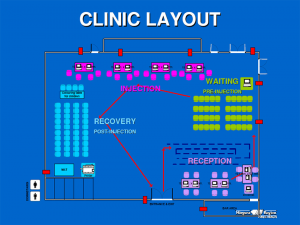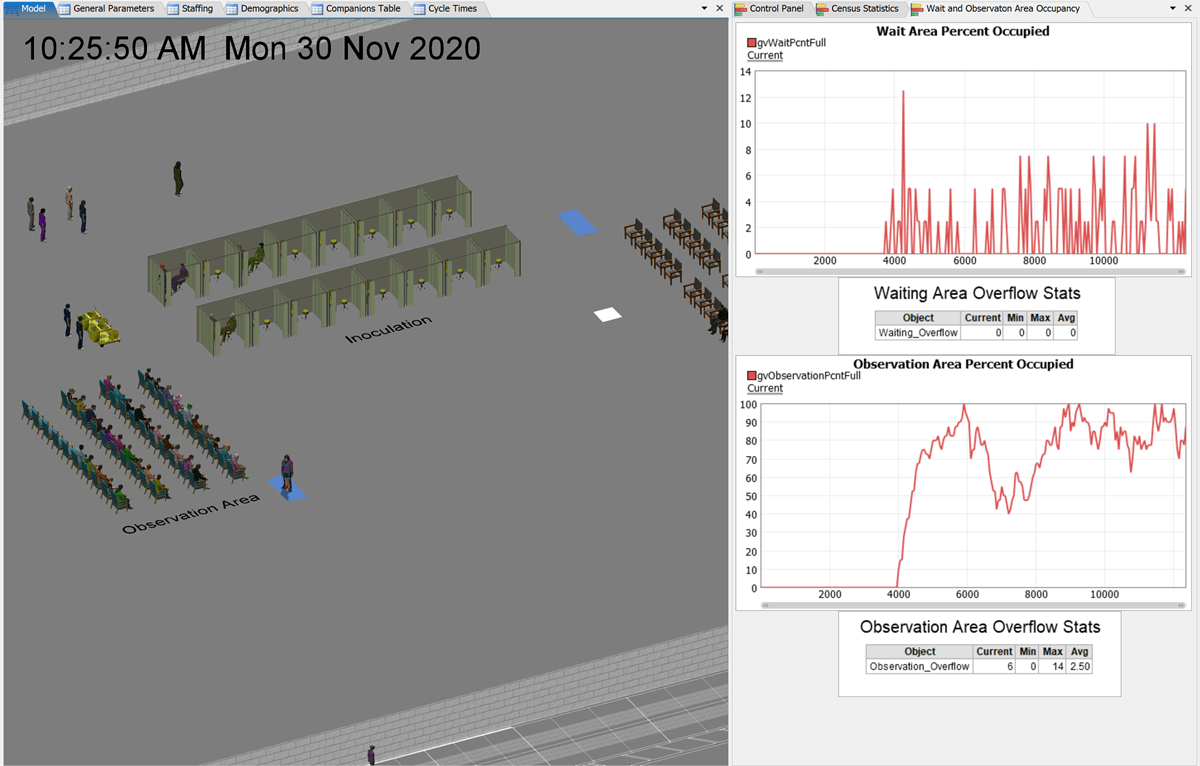I didn’t expect to experience déjà vu while going in to receive my first dose of the COVID-19 vaccine.
My appointment took me to the largest vaccination site in the southern end of the county. I can’t think of a better location to administer vaccines en masse—it’s right off the freeway, on Main Street’s west edge in the largest city in the area. It has a massive parking lot and thousands of square feet of open interior space.
How were they able to find such a location? By using the empty husk of a now-closed department store.

I had déjà vu because I’d seen this before, if only in a FlexSim model. One of my colleagues at FlexSim Canada built a proof-of-concept model last year, in the throes of rising COVID-19 cases in North America and worldwide. The model is loosely based on a mass immunization plan developed by Canada’s Simcoe Muskoka District Health Unit, a strategy they first developed in response to SARS and then revised in 2010 after the H1N1 mass immunization campaign.
From retail to healthcare
The idea is to choose a large, empty “Big Box” store or community center and turn it into a mass inoculation facility. These closed stores offer several advantages as a temporary vaccination site—well-lit parking, climate control, Internet access, and restrooms. They also have ample interior space, enough to appropriately distance patients in waiting areas, observation areas, and everything in-between.
My colleague’s model focused on three staff groups: registration, immunization, and cleaning. Its greatest strength is in a customized control panel to quickly define capacity and layout for the main areas, adjust arrival patterns, and alter the number of staff. To model a different location, you would import a different CAD drawing, define the model parameters, and generate an entirely new model.

I thought about this model quite a bit while getting my vaccination. I was surprised at how many time slots were available when I scheduled my appointment. My family only spent a minute or two waiting for registration before being whisked directly to the immunization area. Yet even on a potentially “light” day, the observation areas were still filling fast. What would the facility look like when appointments increased in the coming weeks? What if a larger-than-normal amount of patients had a history of anaphylactic events and required more time (30+ minutes) in the observation area?
I found myself wanting to run some “what if” tests in a simulation model. I’m guessing some of my county’s health department staff might be interested in the same thing.
Vaccination models in FlexSim
Whether it’s a small clinic or a large, temporary facility, vaccination models have been a popular topic among FlexSim users for the past few months. Some have had to model several sites with drastically different dimensions and inputs. Some have involved drive-thru sites where staff administered vaccinations while the patients stayed in their automobiles. In all cases, the turnaround time was extremely tight.
A recent article by the UAB Reporter shined some light on what one of our clients has been doing for their vaccination planning efforts. The Performance Engineering group at UAB Hospital has created models of at least three of these facilities. It’s helped them make better decisions as their health system began to roll out multiple vaccination sites in nearby communities.
“That is the beauty of simulation; your ideas on workflow can change as you run it,” said Deborah Flint, senior director for Performance Engineering at UAB Medicine. “We want to know the workflow works before a group physically occupies their new space. If we can look at it while the plans are still on paper, before they finish walls and install equipment we can make sure everything is organized and efficient.”
My vaccination experience was quick and uneventful, which is maybe the highest praise you can give to a healthcare organization. I hope your experience is similar—and if not, I hope your local healthcare organizations consider simulation modeling to improve any aspects of the vaccination process. But above all else, I’m grateful to the many practitioners, staff members, the National Guard, and other volunteers who make it possible for all of us to get the vaccine. Stay healthy out there!
